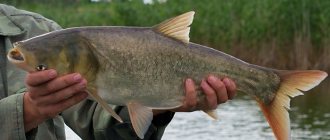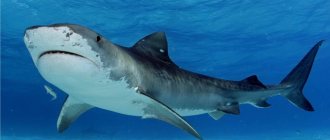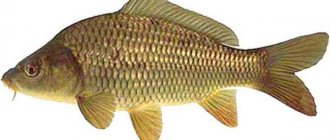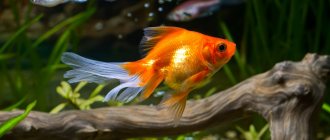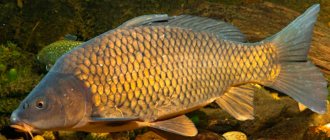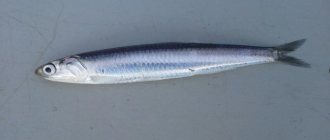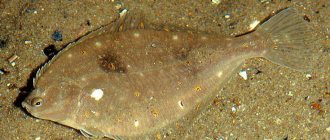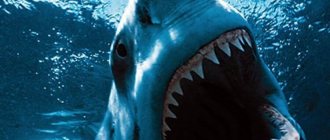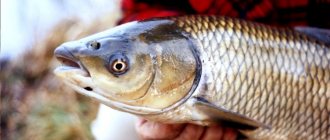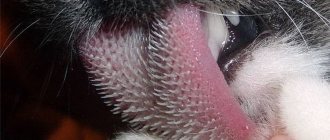The blobfish, the Australian goby or psychrolute (from the scientific name Psychrolutes marcidus), has become widely known as the hero of Internet memes. This is the saddest fish in the world, whose comical but cute appearance is complemented by a drooping “nose”. With the expression of its muzzle and the general amorphousness of its body, this sea creature resembles another hero of the meme, Zhdun. But, unlike him, the drop fish is a real inhabitant of our planet, which is also in danger of complete extinction.
Do you like unusual fish?
- Yes 81%, 1826 votes
1826 votes 81%1826 votes - 81% of all votes
- No 16%, 362 votes
362 votes 16%
362 votes - 16% of all votes
- I don't eat fish 3%, 75 votes
75 votes 3%
75 votes - 3% of all votes
Total votes: 2263
27.07.2020
- Yes 81%, 1826 votes
1826 votes 81%1826 votes - 81% of all votes
- No 16%, 362 votes
362 votes 16%
362 votes - 16% of all votes
- I don't eat fish 3%, 75 votes
75 votes 3%
75 votes - 3% of all votes
Total votes: 2263
27.07.2020
×
You or from your IP have already voted.
Where is it found?
The drop fish lives off the coast of Australia, Tasmania and New Zealand, but it is impossible for humans to meet it in nature. The depth of its habitat is 600-1200 meters, and scuba diving at 40-50 m is already considered deep-sea. Record diving, which required special equipment, the selection of special gas mixtures and many hours of ascent, allowed a person with scuba gear to reach a depth of 332 m. This was done by the Egyptian Ahmed Gabr in 2014.
The worlds of humans and deep-sea fish do not intersect: we cannot live at the pressure native to the drop fish, and she cannot live at ours. The sudden pressure drop when bringing the fish to the surface kills it and significantly changes its appearance.
The Australian goby needs cold water, 6-7 degrees Celsius. They need the seabed to reproduce and feed. These conditions limit the habitat of psychrolutes, and warming of the world's oceans may threaten the survival of the species.
Unlike other cold-loving bottom predators - flounder and halibut - the psycholute does not lie on the bottom, but floats in the water column, so its body has not deformed. But these species compete little with each other; their feeding methods are somewhat different. They dig through the silt and extract crustaceans and mollusks that live in its depth. The food of drop fish is free-swimming crustaceans.
Flounder live in much shallower waters, going down to only 55 meters. Halibuts are deeper-sea, they live and breed at a depth of 300-1200 meters.
Body structure
The blob fish completely lacks a bony skeleton and swim bladder. Under such external pressure, it simply cannot function. Its body has a gel-like consistency, which has a slightly lower density than water. Thanks to this, she is able to effortlessly stay afloat and drift with the current, because she does not have the necessary equipment for high-speed swimming. Of the fins, the most developed is the caudal one, which is responsible for the direction of movement. The pectoral fins are insignificant and allow only lazy paddling in the desired direction.
In water, the drop fish has bulging eyes, which are not without a certain visual acuity even in the pitch darkness of the water depths. But in specimens raised to the surface, they are literally blown away due to a sharp pressure drop.
Related species
The Australian goby is not alone; there are 10 more species in the psycholute family to which it belongs. These are all deep-sea fish that prefer to live in cold waters. This habit gave the family its name: from Greek “psychros” is translated as “cold”. Their common features are a poorly developed pelvic fin and a bare, scaleless body. Other representatives of the psycholute family are found in the Atlantic and Pacific oceans, both in the southern and northern parts, avoiding the equatorial and tropical zones. They live, depending on the species, at depths from 150 to 1000 m.
Appearance
The caught creature looks like a brown or pink droplet without scales, consisting of jelly. Body length rarely exceeds 30 cm, weight up to 2 kg.
The head is in the shape of a flattened ball; from the head to the tail the body narrows, forming a drop. The eyes are small and widely spaced.
There is no swim bladder: at great depths it is ineffective; gas from it would escape due to the high environmental pressure. Therefore, the function of the bubble is performed by the entire body of the psycholute. The gelatinous mass of which it consists is slightly lighter than water, and this allows the fish to move without expending energy. This adaptation allows the fish to exist in conditions of high pressure and small amounts of food.
If you suddenly release the pressure on a liquid, it will expand. In physics lessons we were told that liquids are incompressible. This is not entirely true. They compress, just weaker than gases, but stronger than solids. And, once in conditions of normal pressure, they acquire the same volume. At its native depth, the droplet fish is subject to pressure of 60-120 atmospheres. That’s why she looks much more graceful there and doesn’t have such a sad face at all.
A change in pressure will not change the length of the fish, but the soft tissues will certainly be deformed. This is how the “nose” and other amorphous features arise. By the way, one of the first specimens caught and studied, named “Mr. Blobby”, depicted in the most famous photo of the blob fish, lost its “nose” after being fixed in formaldehyde. This substance not only preserves biological tissues, but also dehydrates them. As a result, the specimen, as seen in another photo of it, looks a little more like an ordinary fish.
Underwater, a living psycholute is not at all like the description of a dull fish. He resembles an ordinary bull. His face has nothing in common with the sad appearance we are used to. His mouth is really large, with thick lips (although not as thick as we are used to seeing in pictures).
The drop fish has an almost complete set of fins: pectoral, dorsal, anal and caudal. It is difficult to notice them in caught fish, but they are there. If a drop of fish lived in the upper layers of water, it could be seen swimming quickly, but in deep conditions, with the help of fins, the psychrolute can rather maintain its position than purposefully move somewhere. The pelvic fin is poorly developed, the first and second dorsal fins are fused together.
What does it eat?
The Australian goby is a predator, unlike most benthic inhabitants that feed on carrion. The main part of the diet of drop fish is small marine invertebrates drifting in the bottom areas. This fish is a passive hunter; it does not swim after prey, but stays in one place. Australian gobies eat the plankton that floats into their mouths.
An important problem with psychrolutes is that at depth there is not as much life, and therefore food, as in the upper layers of the ocean. The fish itself is not very well adapted to moving long distances for food, which means that if it is unlucky, it may be in danger of starvation.
Character and lifestyle
Having practically no muscles, a drop of fish in the water can either not move at all, or drift with bottom currents. Her vision is adapted to her habitat: although the photometer records the sun's rays to a depth of 1,000 meters, the human eye can no longer distinguish light below 600 m; everything around us would seem equally black. And the drop fish manages to navigate in such conditions with the help of vision. In natural conditions, her eyes look completely different from those in terrestrial photographs. They protrude above the surface of the head and protrude slightly forward.
Reproduction and lifespan
Representatives of this species live 5-14 years, on average 8-9. Little is known about how psychrolutes reproduce: the great depth makes it difficult to observe the fish. Therefore, we do not know what their mating rituals are, how the choice of a partner and mating itself occur. However, it turned out that one thing can be learned: drop fish are caring mothers. They lay eggs in the sand, and then protect the clutch and hatched larvae until they turn into full-fledged fry and are able to escape from predators themselves.
The protection of clutches is often found in deep-sea fish, but care for the hatched offspring is not particularly characteristic even for them. An interesting feature is that the Australian goby takes its droplet-like larvae immediately after hatching to even greater depths, to the quietest places possible. This minimizes the likelihood of early encounters between offspring and predators or scavengers, who, on occasion, will not refuse to snack on the fry.
Even such a device, which provides the brood with maximum survival, cannot significantly accelerate the growth rate of the drop fish population. With the same care of females for their cubs, to double the population in the event of a complete cessation of human intervention in the life of psychrolutes, it will take from 4.5 to 14 years for the number of representatives of the species to double. This is a long time for such a process.
Main Enemies
According to modern scientists, the Australian bull has no natural enemies. Theoretically, these could include deep-sea squid, angler fish and other predatory inhabitants of the seabed, but whether this is so, as well as what tactics the psychrolute uses to protect itself from predators, is not known for certain. But it is clear that the population of these inhabitants of the depths is rapidly declining.
This is due to humans, or more precisely, to the bottom fishing of marine crustaceans - lobsters and crabs. Along with the delicacy, a strange, sedentary fish also ends up in the net. Thus, a person casually destroys a species that is edible only conditionally and has no other economic value: after trawling, there is no point in releasing fish into the sea that have received injuries incompatible with life due to a rapid change in pressure. Even if it is alive at the time of catching, death after such exposure is inevitable.
Why is a psycholute considered ugly?
Internet users assigned the status of an ugly ocean inhabitant to a drop of a fish. The corresponding vote was carried out by one British community that tracks populations of phenotypes that smile. The community held a vote, as a result of which the drop received more than 10,000 votes. Because of this vote, oceanographers have paid attention to this phenotype.
People cannot observe the behavior and reproduction of the sad ocean resident at home. After all, creating suitable conditions in an aquarium is problematic. Therefore, those users who are interested in this view have to be content with pictures from the Internet. Oceanographers use technology to film sniffers in the depths of the ocean.
Watch interesting videos about drop fish and more.
AdminAuthor of the article
Did you like the article?
Share with your friends:
Edible or not
The fish is not poisonous, in principle you can eat it, but it has practically no muscles: the body consists mainly of a jelly-like fat mass. It is served only in establishments for exotic lovers. Dishes made from it are expensive, but what is valuable in them is not the nutrients, but the fact of eating such an unusual creature. Chefs prefer to keep recipes for exotic dishes secret. Europeans almost never eat “gelatinous” fish.
Many people wonder if drops eat fish.
Due to its repulsive appearance and lack of nutritional components, it is not eaten in many European countries. If there are dishes that contain a drop, then exotic lovers order such dishes. Residents of Japan and China treat this phenotype with trepidation. The meat of the sniffer is considered a delicacy, therefore it is used in the preparation of unique dishes. And in Asian countries they don’t ask whether this fish is edible. After all, both Chinese and Asian chefs know the recipes for preparing the ugliest specimen. In foreign restaurants, dishes are bought for hundreds of dollars. There are recipes for making sniffer on the Internet.
Security status
Ecologists do not know how much the Australian goby needs protection. Scientists have not been able to calculate how many of these fish now live in the World Ocean, since deep-sea inhabitants are extremely difficult to study. But the genetic diversity of the caught individuals turned out to be small, which means that there is inbreeding within the species. This leads oceanologists to believe that the species is already rare, and threats from trawl fishing for crustaceans off the coast of Australia and New Zealand, as well as warming of the world's oceans, can lead to the fact that the drop fish will remain only in photographs.
You shouldn’t scour the Internet looking for recipes for drop fish dishes. For Europeans it is too exotic, for nature lovers it is rare. It’s also difficult to admire this sea creature - he may be cute, but he’s not handsome. Therefore, the best thing humanity can do for the Australian bull is not to touch it. He made his contribution to art, ecology and even the meme, and deserved to be left alone.
Exhibit in the museum
The very first specimen was discovered in 2003. The fish was spotted and caught off the coast of New Zealand. Fishermen and scientists were very amazed by their unusual find. She was immediately photographed and then sent to the Australian Museum. There it is stored to this day, in a 70% alcohol solution.
They just say that during storage in alcohol, the cute nose of the fish decreased. That's why she doesn't look so funny now. The individual has actually evolved significantly, scientists believe.
After all, there is not much food in deep water, so she needed to somehow conserve her energy and not starve. The fish spends most of its time “resting” and lazing around. When something edible appears nearby, it opens its mouth and makes minimal movements towards the food. Just some kind of hunter and predator of the year!
By the way, about predators. Most likely, the only threat to the creature is people. In some countries, the meat of this individual is even considered a delicacy. Would you eat such a delicious thing?
Interesting Facts
The drop fish was first caught almost 100 years ago, in 1926. She accidentally fell into the nets of Tasmanian fishermen. Then the unusual find was described, the species was given a name, and the study stopped there. Only at the end of the 20th century did psycholute again attract the attention of researchers: thanks to the development of technology, the study of deep-sea fish became somewhat easier.
The unusual appearance of the drop fish has repeatedly attracted the attention of film directors. It appears in The X-Files (episode "Rm9sbG93ZXJz", season 11, episode 7), where it is served to Mulder uncut in a robotic sushi bar. In the film “Men in Black 3,” the chef presented this creature as earthly, but no one believed him: the gelatinous creature with a sad, human-like face bears little resemblance to ordinary representatives of our fauna.
Internet users have repeatedly voted the Australian bull the ugliest animal on the planet. She even won over pubic lice, and since 2013 has been featured on the emblem of the Ugly Animals Conservation Society.
The blobfish, the Australian goby or psychrolute (from the scientific name Psychrolutes marcidus), has become widely known as the hero of Internet memes. This is the saddest fish in the world, whose comical but cute appearance is complemented by a drooping “nose”. With the expression of its muzzle and the general amorphousness of its body, this sea creature resembles another hero of the meme, Zhdun. But, unlike him, the drop fish is a real inhabitant of our planet, which is also in danger of complete extinction.
Population and conservation status of the species
The number of creatures from the psycholute family is small. The population is in danger of extinction due to human activity. Most often, the creatures die before they have time to reproduce, falling into the nets of fishermen who hunt crabs.
Deep trawling annually kills millions of inhabitants of the deep sea and ocean. When towed by nets, both small animals and large fish, including drops, suffer.
According to Wikipedia, to increase the fish population by 50% you will need to wait at least 5 years. People strive to preserve the environment and ensure the safety of rare animals. The drop fish is protected due to numerous appeals from caring people. There is a ban on catching it, but fishermen do not intentionally try to catch it.
The safest habitat for psychrolutes is an area with coral reefs. Environmentalists strive to protect coral settlements in their original form, so they prohibit fishermen from fishing near them.

